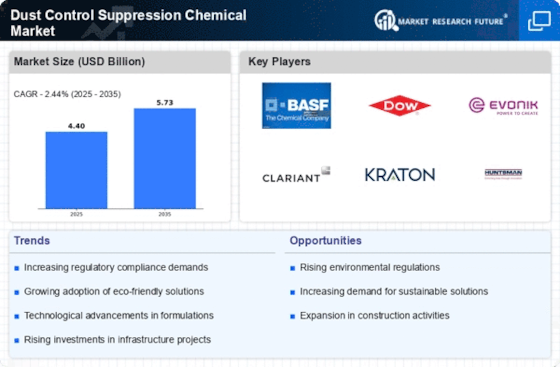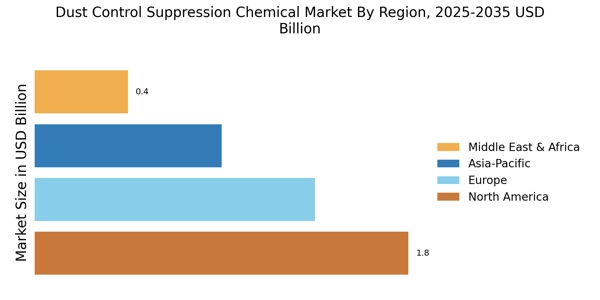Expansion of Mining Activities
The expansion of mining activities is a notable driver for the Dust Control Suppression Chemical Market. As mineral extraction becomes more prevalent, the associated dust emissions pose significant environmental challenges. In 2025, the mining sector is projected to grow at a compound annual growth rate of around 4%, necessitating effective dust control measures. Mining operations are often located in sensitive ecological areas, where dust suppression chemicals are essential to mitigate environmental degradation. This trend is likely to lead to increased investments in dust control solutions, as companies strive to balance operational efficiency with environmental responsibility. The Dust Control Suppression Chemical Market is thus expected to benefit from the rising demand for effective dust suppression technologies in the mining sector.
Increased Construction Activities
The resurgence of construction activities across various sectors appears to be a primary driver for the Dust Control Suppression Chemical Market. As urbanization accelerates, the demand for effective dust control solutions has surged. In 2025, the construction sector is projected to grow at a rate of approximately 5.5% annually, leading to heightened awareness regarding dust emissions. This growth necessitates the use of dust suppression chemicals to mitigate environmental impacts and comply with regulations. Furthermore, construction sites are often subject to stringent dust control measures, which further propels the demand for specialized chemicals. The Dust Control Suppression Chemical Market is thus likely to benefit from this trend, as companies seek to enhance their operational efficiency while adhering to environmental standards.
Rising Awareness of Health Impacts
Growing awareness regarding the health impacts of dust pollution is driving the Dust Control Suppression Chemical Market. Studies have increasingly linked dust exposure to respiratory diseases and other health issues, prompting both public and private sectors to take action. In 2025, it is estimated that the health-related costs associated with dust pollution could reach billions, thereby incentivizing investments in dust control measures. This heightened awareness is leading to a proactive approach in various industries, including construction, mining, and agriculture, where dust emissions are prevalent. Consequently, the demand for effective dust suppression chemicals is likely to rise as stakeholders prioritize health and safety. The Dust Control Suppression Chemical Market stands to gain from this trend, as companies seek to implement solutions that protect both workers and the surrounding communities.
Environmental Regulations and Compliance
The increasing stringency of environmental regulations is a significant driver for the Dust Control Suppression Chemical Market. Governments and regulatory bodies are implementing more rigorous standards to combat air pollution and protect public health. In many regions, construction and mining operations are required to utilize dust suppression chemicals to minimize airborne particulate matter. This regulatory landscape is expected to create a robust demand for effective dust control solutions. For instance, the implementation of the Clean Air Act in various jurisdictions has led to a marked increase in the adoption of dust suppression technologies. As compliance becomes non-negotiable, the Dust Control Suppression Chemical Market is poised for growth, as companies invest in innovative solutions to meet these regulatory requirements.
Technological Innovations in Dust Control
Technological advancements in dust control solutions are emerging as a key driver for the Dust Control Suppression Chemical Market. Innovations such as the development of biodegradable and environmentally friendly dust suppressants are gaining traction. These advancements not only enhance the effectiveness of dust control measures but also align with the growing sustainability focus among industries. In 2025, the market for advanced dust suppression technologies is expected to expand significantly, driven by the need for more efficient and eco-friendly solutions. Companies are increasingly investing in research and development to create products that meet both performance and environmental standards. As a result, the Dust Control Suppression Chemical Market is likely to experience growth fueled by these technological innovations, which offer enhanced efficacy and reduced environmental impact.


















Leave a Comment